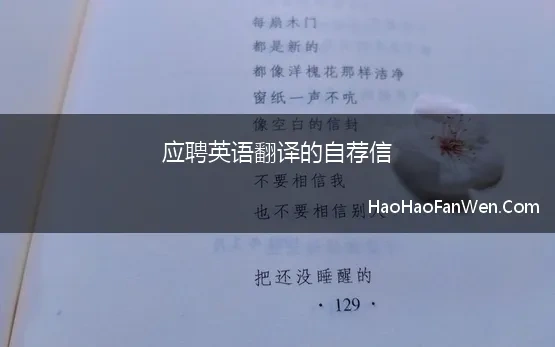医学英语翻译技巧
下面是好好范文网小编收集整理的医学英语翻译技巧,仅供参考,欢迎大家阅读!

病历报告
病历报告的内容和格式
病例报告(casereport),是医学论文的一种常见体裁,通过对一两个生动的病例进行记录和描述,试图在疾病的表现、机理以及诊断治疗等方面提供第一手感性资料的医学报告。
过去,病例报告类论文多是报告一些首次发现的新病例,如艾滋病、军团病都是通过病例报告被人发现的。但随着时间的推移,病例报告类论文目前已主要集中在已知疾病的特殊临床表现、影像学及检验学等诊断手段的新发现、疾病的特殊临床转归、临床诊断治疗过程中的特殊经验和教训等。
病例报告一般分为题目(title)、作者姓名(name)、单位(workingplace)、前言(introduction)、病例介绍(case study)、评论或讨论(comment ordiscussion)、参考文献(reference)等部分。
病例报告的题目要求直接写出病名或新方法及例数,紧扣论文内容,使读者读了以后,对论文报道内容有大致了解。病例报告的前言可有可无,有也应尽可能简短,几句话即可。病例介绍要清楚地交待病程经过的必要细节,要有病人的发病、发展、转归及随访的结果等。
切忌将原始病历照搬,避免使用各种非客观性,各种怀疑或推测性语句。因病例报告所撰写的是有特殊意义的病例,故应将有特殊意义的症状、体征、检查结果、治疗方法详细描述,突现重点。描述病史时,要交待清楚发病时间、主诉及病情经过。对反复发作性疾病和先天性疾病要重视既往史和家族史。
外伤患者要写受伤情况。实验室检查及影像学检查通常只列阳性的和必要的阴性结果。无相关意义的其他阴性结果可省略。对有特殊意义的阳性结果就注意前后对比。手术治疗要说明手术名称、术前处理、术中发现、术后处理、术后反应。治疗结果既要说明疗效,又要说明副作用。
对于病例报告来说,讨论和结论部分是它的核心。如果报告的病例是罕见病,会着重于讨论诊断、鉴定诊断和确认疾病的依据,以及本例的新发现;如果希望报告治疗方面的问题,则着重于讨论治疗方面的经验;如果希望说明误诊方面的问题,则会着重分析误诊原因。此部分常会用一般现在时来表达作者观点。
病历报告各部分的英译
(1)引言部分一般用1-2句话来说明报告对象、目的及意义。
例1∶ Acraniofacial injury is a common disease, but it is rare that acute hepaticfailure appears in a patient with a craniofacial injury.
译文∶颅面损伤是一种常见病,但颅面损伤伴有急性肝功能衰竭却较为罕见。
例2∶We report onecase of Rossai-Dorfman disease,a rare benign disorder of uncertain etiology.
译文∶本文报道一例巨大淋巴结病,一种不明原因的罕见良性疾病。
(2)病史内容包括病人的年龄、性别、病程、症状、体征检查及治疗情况。
例3∶ Awoman aged 27 was admitted with persistent high fever for a long time.
译文∶一位27岁的女性因为长时间的高烧不退而入院。
例4∶He was giventhe diagnosis of arteriosclerosis 4 years ago.
译文∶4年前她被诊断患有动脉硬化。
例5 Clinicalimprovement can be expected within 10 days but full recovery may take a month.
译文∶病情在10天内有望有所改善,但痊愈可能要过一个月。(
(3)病例讨论部分常会做一个结论,或是提出某些警告和强调。
例6 Inconclusion, liver function should be assessed in any patient with unexplainedacute pains in liver area.
译文∶总之,只要病人的肝区有不明的急性疼痛,就得检查肝功能。
例7∶Afteroperation, any hematoma or apparent false aneurysm should be carefullyobserved. for complication.
译文∶手术之后应当密切关注血肿和明显的假动脉瘤,以防并发症的发生。
练习
病历报告翻译示例
Case Report
PatientLi Hua, male, 69 years old, a retired teacher, was admitted on June 6, 1989,because of palpitation for one year and becoming worse in recent 5 months.
Thepatient was quite well until one year before May, 1988. He felt slightpalpitation and dyspnea during hard work, fast walk, or climbing stairs. Therewas swelling of legs in the evening but he felt better after having a rest. Inrecent 5 months, palpitation and dyspnea became so serious that he couldneithei_walk nor lie down. He had to sit up during the whole night, Sometimeshe coughed with small amounts of sputum, but without blood. He had no chill,fever, chest pain or sore joints. The urinating was normal.
Therewas nothing else abnormal in the case history review except a cured lobarpneumonia in 1949. He had no history of drug allergy.
Personalhistory:The patient was born in Xi*an in 1923. He had been to the south ofChina but did not contact contaminated water. He smoked about 10 cigarettesdaily. He got married in 1945. His wife was healthy .They had a daughter whowas also healthy. His father died of stomach cancer. His mother was well.
Physical Examination:T.36.8°C, P. 96/min, R. 28/min,BP.23.5/13.3kPa. The patient, an old fatty man who developed well andmoderately nourished, was lying in bed with a semireclining position. He lookedpale and suffered from general edema. He was mentally, normal and cooperativein the examination. There was no eruption, no jaundice, no purpura on the skin,and the lymph nodes were not palpable. The head, eyes, nose, ears, mouth werenormal while the lips were cyanotic. The neck was soft, there was no venousengorgement. Thyroid glands were not palpable, there were no thrill or brunt.The trachea was in midline. The chest and respiratory movements weresymmetrical. There was no abnormal dullness but some moist rales were heard inthe base areas of the both lungs. The points of maximal impulse (PMI) were notvisible but palpable in the 5th costal interspace, 14cm from the middle line,and there was no thrill.
Thedistance from midstemal line to midclavicular line was 10cm. The heart rate was96/min, regular. There was a grade II soft blowing like systolic murmur at theapex, P2>A2, but no pericardium friction sound was heard. Abdominal wall wassoft without tenderness. The liver was palpable 2cm below the costal marginwith slight tenderness. The spleen was not palpable and there was no shiftingdullness. The rest was normal.
Impression:
Hypertensionand heart disease
degreeIII heart failure
回复“case report”获取答案~
更多医学翻译技巧↓
医学翻译技巧:提高翻译效率的好用动词!
医学翻译技巧:介绍和总结部分用什么时态
医学翻译技巧 | 断句
医学翻译技巧 | 省略
医学翻译技巧 | 逻辑分析和文献验证
About Me
Hi,这里是卢娜 :)
获联合国语言人才培训体系UNLPP英语口笔译证书,任中国知网海外版翻译专家、世界卫生组织WHO、后浪出版社书籍合作译者。
语言让我们聚集于此,了解这个世界更多,欢迎联系lychenwork@,或微博/公众号@卢娜医学翻译。
















